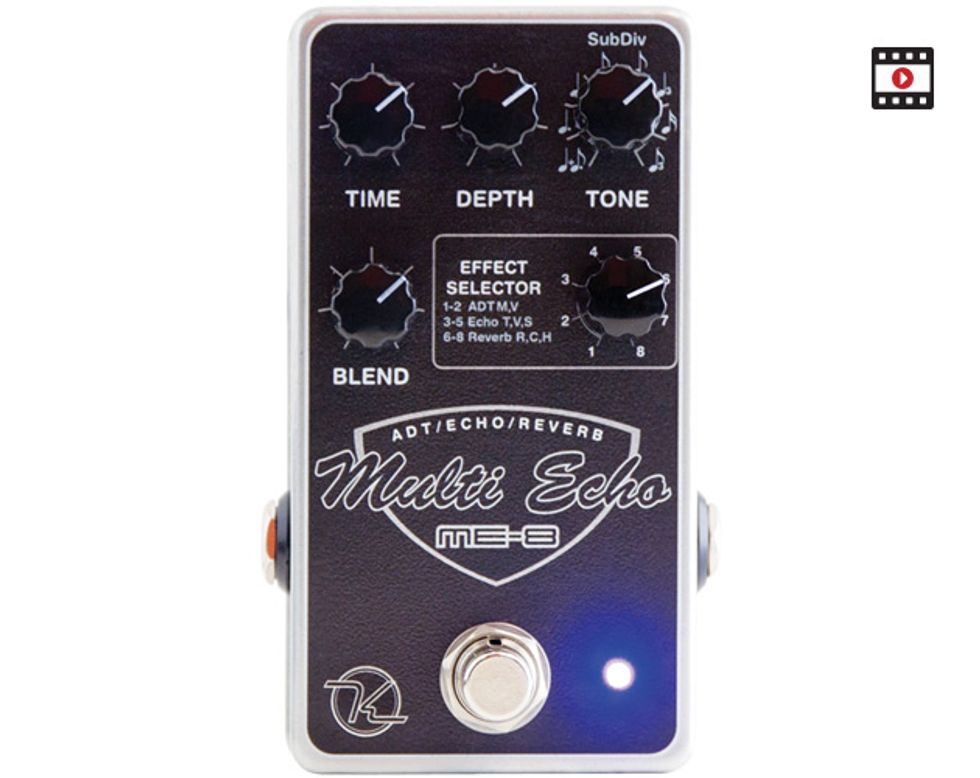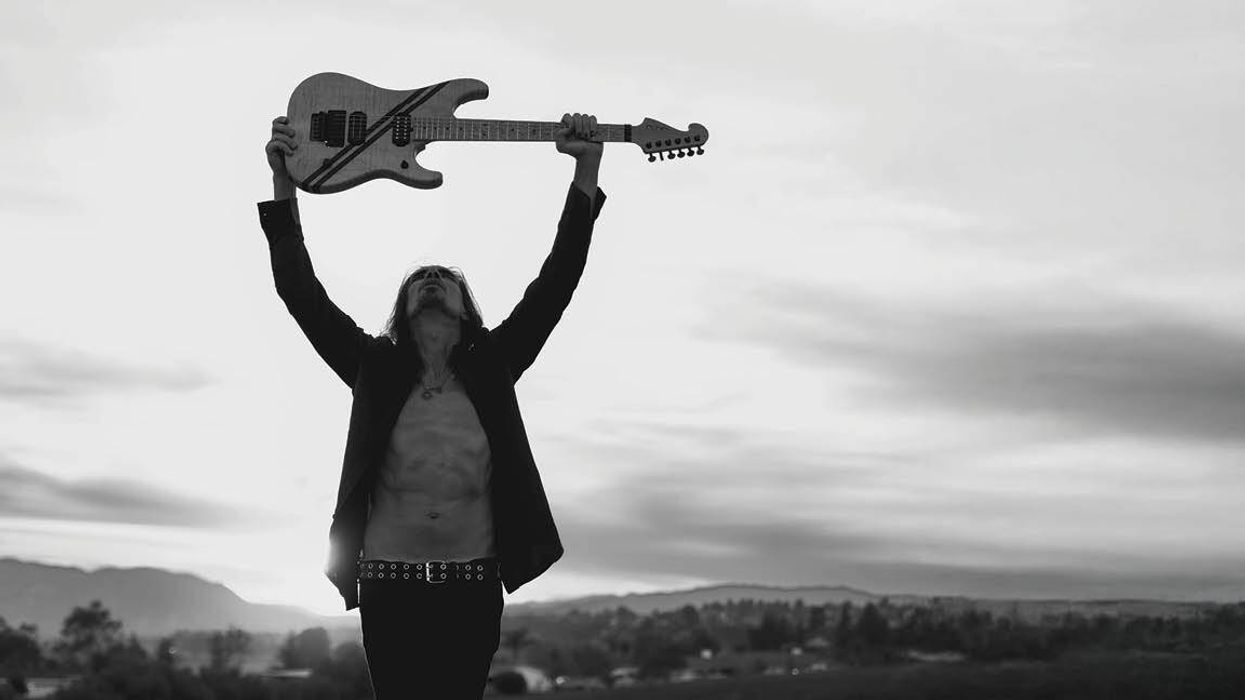With eight effect modes in a single pedal, Keeley’s ME-8 Multi Echo is a time-manipulation toolbox par excellence. It can range from warbling ADT to vintage and modern delay to a handful of reverbs that can serve the most fickle delay and reverb chameleon. And though stuffing so many functions in a compact enclosure creates challenges, this box is a contender for the echo-flavors-per-pedalboard-inch championship crown.
Table for One, Party of Eight
The Keeley Multi Echo’s small footprint means multiple functions for the tone knob, so unless you like figuring out a pedal’s intricacies on the fly, it’s not exactly a plug-and-play experience. A little investigation of how functions change depending on the effect is time well spent. The effect selector rotary knob provides eight echo-mode options: ADT (automatic double tracking) modern, ADT vintage, tape echo, analog delay, digital delay, room reverb, chamber reverb, and hall reverb. The time, depth, and blend knobs function more-or-less conventionally for each selected effect.
The tone knob’s function varies from mode to mode. In ADT vintage and analog delay mode, the tone knob functions as a rate control. When digital delay is selected, the tone knob controls repeat subdivisions—ranging from quarter notes to dotted and triplet eighths. In room reverb, tone controls an added distortion effect—a tip of the hat to Phil Spector’s “room compression” technique. Smartly, Keeley added a quick-reference guide to these functions on the backplate of the ME-8.
Structurally speaking, the ME-8 feels very solid. The circuit layout is compact but predictably crowded given all those functions, and there’s no room left for a 9V battery. The single output is mono only. Sorry stereo echo lovers!
Delays for Days
The ADT mode is essentially Keeley’s 30 ms Double Tracker—an emulation of the process that EMI/Abbey Road and Beatles recording engineer Ken Townsend devised to eliminate the process of manually doubling vocals. Townsend’s ADT was effectively a very short tape delay, and that texture is replicated nicely here. The Modern ADT has a little more headroom in the time department (an extra 20 ms, to be precise), but for my money the vintage ADT is where it’s at.
Adjust the tone control (which, in this case, adjusts the rate of modulation) and you’ll hear layers of chorus-y flutter that would be equally at home mated to a Johnny Marr arpeggio riff or a John Lennon vocal. By itself, the ME-8 is quite transparent in the ADT applications. Placing overdrive before the delay and modulation can make the output sound a bit boxy, however. That seems to attest to the breadth and richness of the ADT mode’s harmonic spectrum as much as anything else. But if you’re an effects-heavy player like myself, you may want to explore a delay setting with a little more headroom.
Ratings
Pros:
Great gigging or session tool. Nice transparency in delays and reverbs without sacrificing color.
Cons:
No battery or stereo functionality. Can’t blend effects.
Tones:
Ease of Use:
Build/Design:
Value:
Street:
$199
Keeley ME-8 Multi Echo
robertkeeley.com
Other delay-altering choices are just as effective for modifying what are, across the board, very nice fundamental delay voices. Digital subdivision will please any Edge or late-model Gilmour fanatic. The analog delay’s dynamic modulation adds a chorus-like wave that enshrouds repeats and varies in intensity depending on your attack. It’s very expressive in live applications and killer for creating mood-shifting post-rock expansiveness or for adding shimmer to an already excellent BBD simulation. Both the tape and analog delays range from 50 ms to 950 ms of delay, while the digital can achieve up to 1000 ms.
Just like the ADT and other delay settings, the ME-8’s reverbs are often striking for their combination of transparency and color—particularly given the very non-transparent nature of its analog inspirations. During a rehearsal session, I set the ME-8 to room reverb and left it on for the duration. I experienced much less (perceived) volume drop and tone suck compared to a lot of the reverb boxes I regularly employ. The room setting has a very cool slapback quality to it, which works well for vintage-minded players, and the tone-knob-controlled distortion present in the output is a cool-enhancing texture. It can add mushiness to higher frequencies—particularly in live settings—but could be a very interesting color to work with in studio situations, especially if you’re chasing down ’60s atmospherics.
The Verdict
Perhaps the only complaint I can levy against the Keeley ME-8 is that you can’t blend the effects. For a stompbox that’s filled with so many cool features and great sounds, it’s a bit agitating that you can’t use any of them together. Several moments of inspiration sparked by the ME-8’s cool sounds found me wanting to trade the compact size for a little extra functionality. Still, for $199, this is a wickedly powerful session or gigging tool that can enable considerable pedalboard streamlining or serve as the cornerstone of a stripped-down selection of pedal essentials.
Watch the Review Demo:








![Rig Rundown: Russian Circles’ Mike Sullivan [2025]](https://www.premierguitar.com/media-library/youtube.jpg?id=62303631&width=1245&height=700&quality=70&coordinates=0%2C0%2C0%2C0)

















